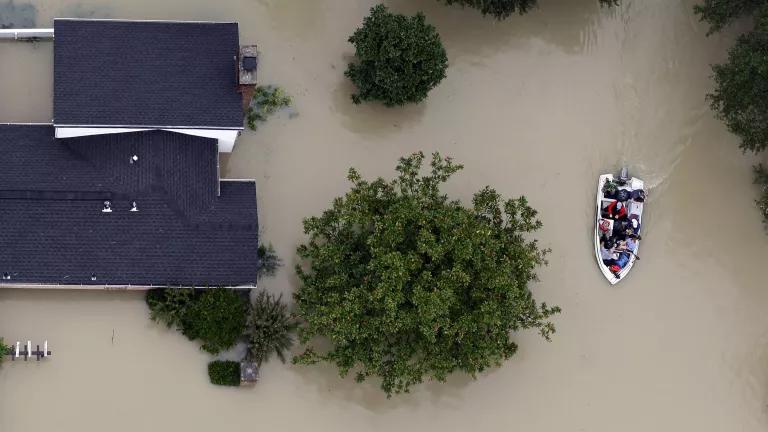
Residents evacuate their homes near Houston’s Addicks Reservoir as floodwaters from Harvey rise, Tuesday, August 29, 2017.
The 2007 United Nations Foundation and Sigma Xi report on climate change warned that confronting the challenge means “avoiding the unmanageable and managing the unavoidable.” Ten years later, it is clearer than ever that to address the greatest environmental threat of our time, we need to both reduce the risk of climate catastrophe and prepare for climate consequences.
All across America, we are facing the increased threat of storms supercharged by climate change, which exacerbate existing social inequities in historically impacted communities. In order to protect people, our homes, and our communities, we need to adopt a five-pronged strategy of preparedness, mitigation, and resiliency.
1. Protect People’s Health
- Establish environmental health protection, resiliency planning, and recovery programs aimed specifically at protecting the most vulnerable populations, including environmental justice communities, persons with preexisting medical conditions, and persons without the financial resources to fully protect themselves and the health of their families.
- Protect against toxic exposures by
- Comprehensively evaluating the safety of disaster-caused toxic and chemical contamination
- Performing cleanups as needed to protect public health under the national contingency plan (the federal law that regulates federal response to disasters). The U.S. Environmental Protection Agency must play a critical role to ensure health protections are met and to fill in when states are stretched thin and working with limited resources.
2. Improve Federal Flood-Protection Programs
- Reinstate federal flood-protection standards that require all federally funded infrastructure projects to meet a higher margin of safety for future sea-level rise and flooding from coastal storms and extreme weather events.
- Reform the National Flood Insurance Program to
- Provide more disclosure of flood risks to homeowners, buyers, and renters
- Ensure that government flood-risk maps show how sea-level rise and other impacts of climate change will make floods more likely in the future
- Phase out subsidized flood insurance premiums, which encourage people to move into areas susceptible to flooding
- Expand funding and availability of assistance to help repeatedly flooded homeowners relocate out harm’s way
3. Advance Local, State, and Federal Climate Preparedness and Resiliency Planning
- Enhance protections for coastal and freshwater wetlands and advance implementation of other “natural barriers” (e.g. oyster reefs, sea grass, dunes) to protect communities from storm surges and rising waters. In tandem, prevent the Trump administration’s attempt to repeal the Clean Water Rule, an essential tool for protecting wetlands.
- In collaboration with community partners, increase investments in cost-effective green infrastructure to help absorb stormwater runoff (while beautifying both coastal and inland communities). Convert vacated flood-prone properties into wetlands, parks, and green spaces to absorb flood waters and act as storm buffers for historically impacted communities.
- Ensure that the Federal Emergency Management Agency (FEMA) requires states to develop disaster preparedness plans that recognize increased flooding and other disaster risks from our changing climate.
- Strengthen the National Environmental Policy Act (NEPA) and state environmental review procedures so that proposed projects fully analyze resilience and energy efficiency alternatives in light of climate change realities.
4. Rebuild with Community Needs and Climate Resiliency as Twin Goals
- Ensure that historically impacted communities—which have inherent expertise when it comes to resiliency and mitigation efforts—are given a leadership role in managing how resources are distributed to facilitate just and equitable rebuilding efforts.
- Create a new Rebuild by Design or National Disaster Resilience competition, two past disaster preparedness and recovery efforts that emphasized long-term resilience, bottom-up community engagement, and future-oriented planning.
- Ensure that public housing and affordable housing get the resources needed for better rebuilding. Rebuilding plans in the wake of weather events will naturally seek to capitalize on the investment potential of vacated spaces, leaving low-income families with nowhere to return to and little voice in determining the pattern of recovery. We must ensure that efforts to recover and enhance the built environment leave no one behind.
- Develop state and regional rebuilding plans that apply “redundancy” to the community rebuilding effort—multiple transport systems, distributed energy grids, schools able to double as shelters, etc., that protect against climate change impacts and reduce climate change pollution.
5. Address Root Causes of Climate Change
- Address the root causes of climate change to mitigate long-term changes in weather-related disasters by accelerating the shift away from dirty fossil fuels and toward cleaner, smarter ways to power our future. That includes:
- Reducing carbon dioxide and other greenhouse gas pollution from existing power plants and the broader power sector
- Significantly scaling up energy efficiency
- Increasing the deployment of renewable energy, clean distributed generation, and electric vehicles
- Support frontline community-based advocacy for climate and environmental justice and against the harmful impacts of fossil fuels on health, air, and water.



